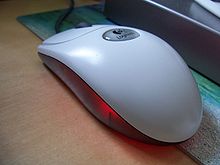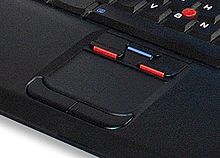Pointing device: Difference between revisions
Mahavir.coep (talk | contribs) |
Mahavir.coep (talk | contribs) |
||
| Line 35: | Line 35: | ||
*Finger-mouse – An extremely small mouse controlled by two fingers only; the user can hold it in any position |
*Finger-mouse – An extremely small mouse controlled by two fingers only; the user can hold it in any position |
||
*Gyroscopic mouse - A [[gyroscope]] senses the movement of the mouse as it moves through the air. Users can operate a gyroscopic mouse when they have no room for a regular mouse or must give commands while standing up. This input device needs no cleaning and can have many extra buttons, in fact, some laptops doubling as TVs come with gyroscopic mice that resemble, and double as, remotes with LCD screens built in. |
*Gyroscopic mouse - A [[gyroscope]] senses the movement of the mouse as it moves through the air. Users can operate a gyroscopic mouse when they have no room for a regular mouse or must give commands while standing up. This input device needs no cleaning and can have many extra buttons, in fact, some laptops doubling as TVs come with gyroscopic mice that resemble, and double as, remotes with LCD screens built in. |
||
*Wireless Acceleometer Mouse - A [[accelerometer]] senses tilt of movement in air which then can be mapped on to computer screen for tilt based mouse.Wireless module can give it capability of free movement in air & ease of use. |
*[http://coepetc.blogpspot.com Wireless Acceleometer Mouse] - A [[accelerometer]] senses tilt of movement in air which then can be mapped on to computer screen for tilt based mouse.Wireless module can give it capability of free movement in air & ease of use.It can be well used in Gaming application & Gesture recognition. |
||
* [[light pen]] |
* [[light pen]] |
||
* [[light gun]] |
* [[light gun]] |
||
Revision as of 09:31, 14 June 2008


A pointing device is an input interface (specifically a human interface device) that allows a user to input spatial (ie, continuous and multi-dimensional) data to a computer. CAD systems and graphical user interfaces (GUI) allow the user to control and provide data to the computer using physical gestures — point, click, and drag — for example, by moving a hand-held mouse across the surface of the physical desktop and activating switches on the mouse. Movements of the pointing device are echoed on the screen by movements of the pointer (or cursor) and other visual changes.
While the most common pointing device by far is the mouse, many more devices have been developed. However, mouse is commonly used as a metaphor for devices that move the cursor.
For most pointing devices, Fitts' law can be used to predict the speed with which users can point at a given target position.
Examples of pointing devices
Common devices
- Based on rolling a ball
- Mouse – a small handheld device pushed over a horizontal surface.
- Mini-mouse – a small egg-sized mouse for use with laptop computers; usually small enough for use on a free area of the laptop body itself, it is typically optical, includes a retractable cord and uses a USB port to save battery life.
- Trackball – a rollable ball mounted in a fixed base; essentially an upside-down mouse.
- Based on touching a surface
- Touchpad – a flat surface that can detect finger contact, this is the norm for modern laptop computers; at least one physical button normally comes with the touchpad, but the user can also generate a mouse click by tapping on the pad; advanced features include pressure sensitivity and special gestures such as scrolling by moving one's finger along an edge.
- Graphics tablet – a special tablet similar to a touchpad, but controlled with a pen or stylus that is held and used like a normal pen or pencil; the thumb usually controls the clicking via a two-way button on the top of the pen, or by tapping on the tablet's surface.
- Touchscreen – framed around the monitor and resembling a monitor shield, this device uses software calibration to match screen and cursor positions; many firms will integrate touchscreen equipment into existing displays and all-in-one devices (such as portables PCs) for a fee.
- Based on moving a stick
- Isotonic joysticks – where the user can freely change the position of the stick, with more or less constant force
- Isometric joysticks – where the user controls the stick by varying the amount of force they push with, and the position of the stick remains more or less constant
- Pointing stick – a pressure sensitive nub used like a joystick on laptops, usually found between the g, h, and b keys on the keyboard.
Other pointing devices

- Palm mouse – held in the palm and operated with only two buttons; the movements across the screen correspond to a feather touch, and pressure increases the speed of movement.
- Footmouse – a mouse variant for those who do not wish to or cannot use the hands (see carpal tunnel) or the head; instead, it provides footclicks.
- Similar to a mouse is a puck, in which rather than tracking the speed of the device, it tracks the absolute position of a point on the device (typically a set of crosshairs painted on a transparent plastic tab sticking out from the top of the puck). Pucks are typically used for tracing in CAD/CAM/CAE work, and are often accessories for larger graphics tablets.
- Eyeball-controlled – A mouse controlled by the user's eyeball/retina movements, allowing cursor-manipulation without touch.
- Finger-mouse – An extremely small mouse controlled by two fingers only; the user can hold it in any position
- Gyroscopic mouse - A gyroscope senses the movement of the mouse as it moves through the air. Users can operate a gyroscopic mouse when they have no room for a regular mouse or must give commands while standing up. This input device needs no cleaning and can have many extra buttons, in fact, some laptops doubling as TVs come with gyroscopic mice that resemble, and double as, remotes with LCD screens built in.
- Wireless Acceleometer Mouse - A accelerometer senses tilt of movement in air which then can be mapped on to computer screen for tilt based mouse.Wireless module can give it capability of free movement in air & ease of use.It can be well used in Gaming application & Gesture recognition.
- light pen
- light gun
- eye tracking devices
- steering wheel - can be thought of as a 1D pointing device
- yoke (aircraft)
- jog dial - another 1D pointing device
- Some high-degree-of-freedom input devices
- spaceBall - 6 degrees-of-freedom controller
- discrete pointing devices
- directional pad - a very simple keyboard
- dance pad - used to point at gross locations in space with feet
- Wii Remote - pointer function with motion sensing controls on Wii
- soap mouse - a handheld, position-based pointing device based on existing wireless optical mouse technology
